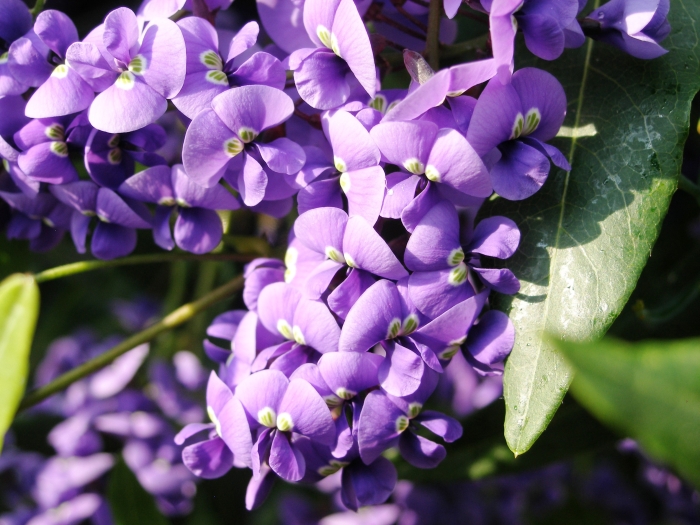False Sarsaparilla
(Hardenbergia violacea)
False Sarsaparilla (Hardenbergia violacea)
/
/

Dryas
CC BY-SA 3.0
Image By:
Dryas
Recorded By:
Copyright:
CC BY-SA 3.0
Copyright Notice:
Photo by: Dryas | License Type: CC BY-SA 3.0 | License URL: https://creativecommons.org/licenses/by-sa/3.0 | Uploader: Dryas | Publisher: Wikimedia Commons | Title: Hardenbergia_violacea_RBGK.JPG |


























































































Estimated Native Range
Summary
Hardenbergia violacea, commonly known as False Sarsaparilla, Purple Coral Pea, or Waraburra, is a climbing or prostrate sub-shrub endemic to Australia, particularly found in open woodlands and forest margins. It has wiry stems that can extend up to 2 m (6 ft 7 in) or more. This plant is characterized by its vibrant racemes of twenty to forty purple or violet flowers, which can also appear in pink, white, and other colors, blooming predominantly from August to November. The fruit is a pod containing six to eight kidney-shaped seeds. The flowers are showy and make a striking display when in full bloom.
Hardenbergia violacea is valued for its ornamental flowers and as a versatile plant in cultivation, suitable for trellises, fences, and as ground cover. It is also used for habitat restoration and erosion control. In cultivation, it thrives in full sun and well-drained soil, is moderately frost-tolerant, and benefits from pruning. While it is hardy in mild and coastal areas, it requires protection from severe cold. Popular cultivars include ’Happy Wanderer’, ’Free N Easy’, and ’Bushy Blue’. It can be invasive if not managed properly, and while generally disease-resistant, it can suffer from root rot in poorly drained soils.CC BY-SA 4.0
Hardenbergia violacea is valued for its ornamental flowers and as a versatile plant in cultivation, suitable for trellises, fences, and as ground cover. It is also used for habitat restoration and erosion control. In cultivation, it thrives in full sun and well-drained soil, is moderately frost-tolerant, and benefits from pruning. While it is hardy in mild and coastal areas, it requires protection from severe cold. Popular cultivars include ’Happy Wanderer’, ’Free N Easy’, and ’Bushy Blue’. It can be invasive if not managed properly, and while generally disease-resistant, it can suffer from root rot in poorly drained soils.CC BY-SA 4.0
Plant Description
- Plant Type: Vine
- Height: 3-8 feet
- Width: 1-2 feet
- Growth Rate: Rapid
- Flower Color: Pink, Purple, White
- Flowering Season: Spring, Winter
- Leaf Retention: Evergreen
Growth Requirements
- Sun: Full Sun, Part Shade
- Water: Medium
- Drainage: Slow, Medium, Fast
Common Uses
Bee Garden, Bird Garden, Border Plant, Butterfly Garden, Drought Tolerant, Groundcover, Hummingbird Garden, Low Maintenance, Potted Plant, Salt Tolerant, Showy Flowers, Street Planting
Natural Habitat
Open woodlands and forest margins
Other Names
Common Names: False Sarsaparilla, Waraburra
Scientific Names: , Hardenbergia violacea, Hardenbergia monophylla, Kennedia monophylla, Kennedya monophylla, Kennedia ovata, Glycine bimaculata, Hardenbergia ovata, Hardenbergia bimaculata, Caulinia monophylla
GBIF Accepted Name: Hardenbergia violacea (Schneev.) Stearn